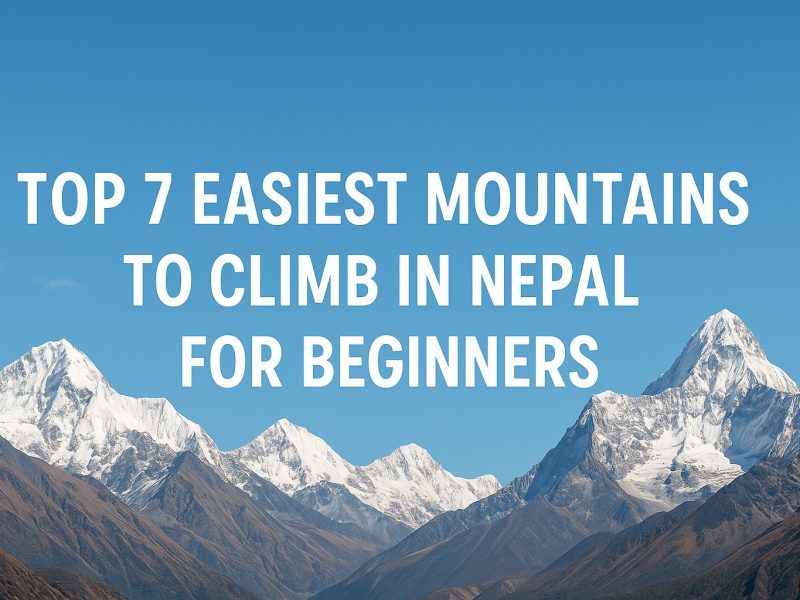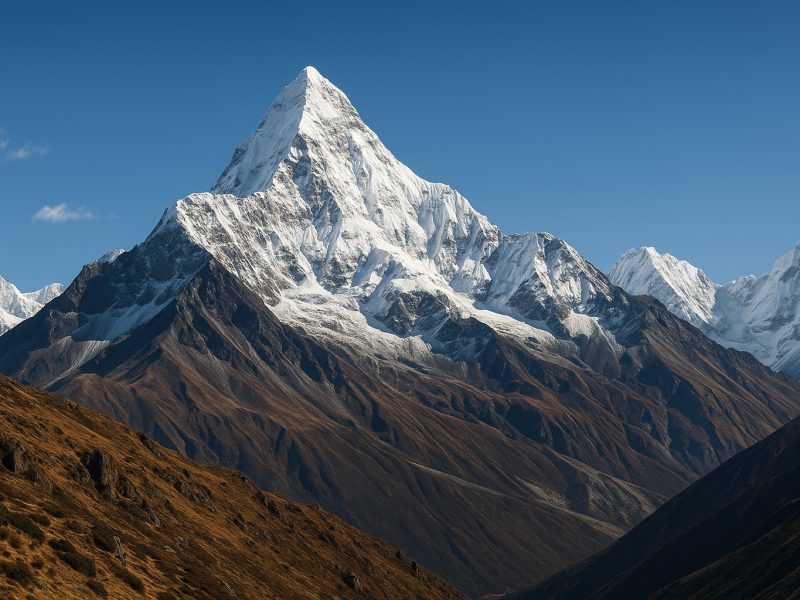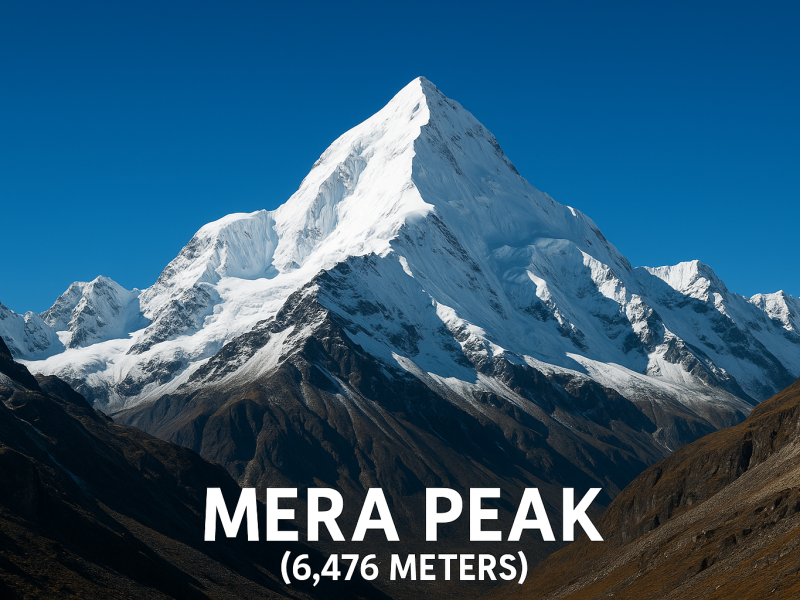
Nepal is one of the best destinations in the world for beginner climbers seeking to experience the magic of the Himalayas. With its stunning snow-capped peaks, serene mountain villages, and welcoming local people, Nepal offers the perfect blend of natural beauty and adventure. Many of the mountains here are not too high or technical, which means you don’t need to be an expert to start your climbing journey. It’s a great place to try your first Himalayan climb in a safe and supportive environment.
One of the biggest reasons Nepal is perfect for beginners is the strong support system. Many experienced guides, porters, and climbing experts are ready to help you every step of the way. These local teams take care of everything — from carrying your gear to setting up camps — so you can focus on enjoying the climb. Guided climbing in Nepal is very safe because the guides know the mountains well and can help with altitude, weather, and safety. Plus, you’ll always have a helping hand when you need it.
Adventure tourism in Nepal is growing every year, and more and more first-time climbers are choosing Nepal to start their journey. Whether you dream of standing on a snowy summit or just want to enjoy a taste of mountain adventure, beginner peaks like Island Peak, Mera Peak, and Yala Peak are perfect for you. These climbs are exciting, but not too difficult — ideal for those who are physically fit and eager to learn. Nepal is truly a dream destination for anyone who wants to try Himalayan climbing in a beautiful and beginner-friendly way.
When people say a mountain is “beginner-friendly,” they mean it’s safer and easier for someone who has never climbed a big mountain before. These peaks are usually lower in height, have simple climbing paths, and offer the right support to help new climbers succeed and stay safe. Below are the most important things that make a mountain perfect for beginners:
1. Lower Altitude and Easier Climbing Routes
Beginner-friendly mountains in Nepal are usually below 7,000 meters, which means the air is not as thin, and the risk of altitude sickness is lower. These peaks have non-technical or semi-technical routes, meaning you don’t need advanced climbing skills like using ropes or ice axes all the time. Mountains like Island Peak (6,189m) and Mera Peak (6,476m) are great examples. They might have some snow and glaciers, but with basic training and the help of guides, most beginners can climb them successfully.
2. Local Guides and Support Services
What really helps beginners is having strong support from local guides, porters, and trekking agencies like Nature Heaven Treks and Expedition. These experienced teams make sure you’re safe, help carry your bags, cook food, and guide you on the right path. They also teach you basic skills if the climb gets a little tricky. Having a trusted team gives new climbers confidence and makes the journey much more enjoyable and less stressful.
3. Good Logistics and Safety Backup
Beginner-friendly peaks have good logistics like teahouse accommodation, gear rental services, rescue access, and internet or mobile network in many areas. You don’t need to carry a tent or heavy cooking gear. If there’s an emergency, helicopter rescue is often available. You can also rent climbing boots, jackets, harnesses, and crampons in places like Kathmandu or Lukla, which makes your packing easier. All these things help make the experience smoother and safer, especially for first-time climbers.
✅ Tip: Always choose a beginner peak with proper acclimatization days and climb with a trusted company like Nature Heaven Treks and Expedition for safety and a great experience.
If you’re planning to climb a beginner-friendly mountain in Nepal, you don’t need to be a super athlete — but you do need basic fitness. You should be able to walk for 4 to 6 hours a day at a slow and steady pace, even uphill. Having good stamina, some hiking experience, and basic body strength (especially in your legs and back) will make your climb much easier and more enjoyable. Remember, most beginner peaks are not technical, but the altitude, cold weather, and long walking days can be challenging if you’re not prepared.
To get ready for your first climb, start training at least 2 to 3 months before your trip. Do cardio exercises like walking, jogging, swimming, or cycling to build stamina. Practice hiking with a backpack, gradually increasing the weight to get used to carrying your gear. If possible, try short hikes or hill walks in your area. Even better, practice on rough or rocky trails. Some light mountaineering practice — like using hiking poles or walking on snow — can also help. You don’t need full climbing training, but learning basic skills will give you more confidence on the mountain.
Beginner climbs are suitable for people of most ages, from teenagers to seniors, as long as you are healthy and active. If you have heart problems, asthma, or serious joint pain, it’s better to check with your doctor first. Many people in their 40s, 50s, and even 60s successfully climb beginner peaks every year in Nepal. It’s all about going slow, listening to your body, and preparing well. With the right training, mindset, and support from expert guides, you can enjoy your first Himalayan climbing adventure safely and proudly.
If you want to climb a beginner mountain in Nepal, you need some important permits and documents. First, you must get a climbing permit from the Nepal Mountaineering Association (NMA). This is required for many trekking peaks like Island Peak, Mera Peak, or Pisang Peak. In addition, you will also need a TIMS Card (Trekkers’ Information Management System) and an entry permit for the national park or conservation area you are entering—such as Sagarmatha National Park or Annapurna Conservation Area. For some peaks, there may also be a garbage deposit (refundable after cleanup) and a Liaison Officer (a government representative who may or may not be compulsory, depending on the peak).
You can get these permits in Kathmandu or Pokhara, or you can let a registered trekking agency like Nature Heaven Treks and Expedition handle everything for you. Applying is now easier than before—some permits can be done online, but most climbers prefer to go through an agency because the rules can be confusing. With the right paperwork, your adventure to the top of a Himalayan peak will be safe, legal, and smooth. Always make sure your permits are ready before your journey begins!
If you are planning to climb a beginner-friendly mountain in Nepal, the best seasons are spring (March to May) and autumn (September to November). During spring, the weather is warm and the skies are usually clear. You’ll enjoy beautiful views of the snow-covered peaks, blooming rhododendron forests, and stable trail conditions. In autumn, the weather is very stable, the skies are crystal clear, and the temperature is just right—not too hot, not too cold. These months are the safest and most popular times for trekking and climbing in Nepal.
Try to avoid the monsoon season (June to August) because there is heavy rain, slippery trails, and cloud-covered mountains—making it dangerous and not fun for beginners. Winter (December to February) is very cold with deep snow and harsh winds, especially at higher altitudes, so it’s not recommended unless you have good winter climbing experience. When choosing the best time to climb in Nepal, think about your own schedule, comfort with weather conditions, and physical readiness. Planning your Nepal climbing adventure in spring or autumn means better weather, higher safety, and more enjoyable views.

If you’re a beginner planning to climb a mountain in Nepal, it’s very important to have the right gear. The basic climbing gear includes strong climbing boots that keep your feet warm and steady, a safety harness, crampons for walking on ice, a helmet to protect your head, and climbing ropes. For your comfort in the cold, you’ll also need a warm sleeping bag (good for -15°C or colder), a thick down jacket, thermal layers (inner and outer), warm gloves, and UV-protected sunglasses to protect your eyes from the snow and sun. All these items help you stay warm, safe, and ready for high-altitude climbing.
If you don’t want to buy everything, don’t worry. You can rent most of the climbing gear in Kathmandu or Pokhara at reasonable prices. Many guided climbing packages in Nepal (like those offered by Nature Heaven Treks and Expedition) include gear rental, accommodation, permits, food, professional climbing guides, and porters. This makes your trip much easier and stress-free. Whether you’re planning to climb Island Peak, Mera Peak, or any other beginner mountain, having the right gear and a good team can make your first Himalayan climbing experience safe, comfortable, and enjoyable.

1. Island Peak (6,189 meters) – Most Popular Beginner Peak
Island Peak is the most famous beginner-friendly mountain in Nepal. It is located in the Everest region and is often climbed after the Everest Base Camp Trek. The climb is not too technical, but you need basic training and a good fitness level. The climb takes around 18–20 days, including trekking and acclimatization. You’ll see amazing views of Lhotse, Ama Dablam, and Everest. The best time to climb Island Peak is spring (March–May) and autumn (September–November). This is the perfect mountain if you want your first Himalayan climbing experience to be exciting and beautiful.

2. Mera Peak (6,476 meters) – Highest Trekking Peak in Nepal
Mera Peak is the highest trekking peak in Nepal, but surprisingly it’s not very technical. It is located in the Hinku Valley, near the Everest region. Climbing Mera Peak is more about endurance than skill. The journey takes 18–21 days, and you’ll pass through peaceful forests, remote villages, and beautiful glaciers. From the top, you can see five of the world’s tallest mountains! Even though it’s high, it’s a great challenge for strong beginners. Best seasons are spring and autumn for clear skies and safe conditions.
3. Lobuche East (6,119 meters) – Epic Views in the Everest Region
Lobuche East is a beautiful peak close to the Everest Base Camp. It offers a thrilling climb and jaw-dropping views of Mt. Everest, Lhotse, and Nuptse. The climb is slightly more technical than Island Peak, so it’s best for beginners who have some basic training or experience. The expedition usually takes 16–18 days, including acclimatization. This mountain is perfect for those looking for an Everest region climbing experience with fewer crowds. The best time to climb is from March to May and September to November.
4. Yala Peak (5,520 meters) – Best Peak for First-Time Climbers
Yala Peak is the easiest and best starter climbing peak in Nepal. It lies in the Langtang region, which is not far from Kathmandu. You don’t need technical skills to climb this mountain. The whole trip takes about 10–12 days, and it’s a good introduction to high-altitude climbing. From the summit, you can enjoy views of Langtang Lirung and even see Tibet on a clear day. Yala Peak is perfect if you want a short, affordable, and beginner-friendly climb.
5. Pisang Peak (6,091 meters) – Annapurna Adventure with Climb
Pisang Peak is in the Annapurna region, along the popular Annapurna Circuit Trek. This climb mixes trekking and climbing, giving you the best of both worlds. The peak is non-technical, but a bit steeper than others, so some basic training is helpful. The full trip usually takes around 18–20 days. The best time to climb Pisang Peak is spring and autumn when the weather is clear. This is a great choice if you want to explore Annapurna and try climbing at the same time.
6. Chulu Far East (6,059 meters) – Quiet and Scenic Beginner Climb
Chulu Far East is another easy trekking peak in the Annapurna region. It is a peaceful and less crowded mountain, great for those who want to avoid busy routes. The climb is not very technical, making it good for beginners who are physically fit. The journey takes about 17–20 days, including trekking through the Annapurna trails. From the summit, you’ll see amazing views of Annapurna II, III, IV, and Manaslu. It’s best to go during spring or autumn when the skies are clear.
7. Dhampus Peak (6,012 meters) – Short and Scenic Climb
Dhampus Peak is a perfect introductory peak for first-time climbers. It is located near the Dhaulagiri and Annapurna ranges, offering stunning views without much technical difficulty. The climb is often combined with the Dhaulagiri Circuit Trek, but you can also plan a shorter version. The expedition takes around 12–14 days. Dhampus Peak is a great way to start your Himalayan climbing journey with a safe, short, and scenic adventure. Ideal months are March–May and September–November.
When picking your first Himalayan peak, think about what fits you. Some mountains are easier and lower in height, like Yala Peak (5,500m) in Langtang, while others like Island Peak (6,189m) in the Everest region are a bit more challenging. If you want amazing views of Mount Everest, choose a peak in the Everest region. If you like quieter trails with forests and culture, the Annapurna or Langtang regions are better. Also, think about how many days you have — some climbs need only a few days, while others need over two weeks for both trekking and summiting.
If you’re short on time, you can go for peaks like Pisang Peak or Mardi Himal, which take about 7 to 10 days. But if you want the full adventure — trekking and climbing — then Island Peak or Lobuche East are perfect and take around 15–18 days. Choose based on your fitness, trekking experience, and personal dream. Do you want to walk near Everest? Or explore peaceful villages in Annapurna? No matter what you choose, beginner-friendly peaks in Nepal offer stunning scenery, safe routes, and unforgettable memories.
Trekking in Nepal’s high mountains is exciting, but it can also be risky if you’re not fully prepared. That’s why going with a local guide or trekking company is a smart choice. They know the best trekking routes, help you walk at the right pace for altitude acclimatization, and keep you safe. A local guide also gives first aid if you feel sick and knows what to do in an emergency. If the weather changes or the trail gets tricky, they will find the safest way to continue. Trekking companies also assist with emergency rescue, travel insurance advice, and planning your daily trek.
Another big advantage is they take care of everything for you—from trekking permits, lodges, and meals, to arranging porters and gear. This makes your journey stress-free. Local guides also explain the culture, traditions, and language of the region, so your trek is not just a walk but a learning experience too. You’ll meet local people, try traditional food, and understand the Himalayan lifestyle better. Whether it’s the Everest Base Camp Trek, Annapurna Circuit, or Manaslu Region, going with an experienced Nepali team like Nature Heaven Treks and Expedition ensures a safe, enjoyable, and unforgettable adventure.
Climbing in Nepal’s Himalayas is exciting, but staying safe is very important. One of the biggest dangers in the mountains is Altitude Sickness (AMS). It happens when you go up too high, too fast. To stay safe, acclimatization is key. This means taking time to let your body adjust to the thin air. Always follow the “climb high, sleep low” rule and add rest days to your itinerary. If you feel headache, dizziness, nausea, or shortness of breath—these are signs of AMS. Don’t ignore them. Go slowly and never rush to the top. Your body needs time.
Drink lots of water to stay hydrated, eat enough high-energy food, and keep a steady walking pace. Don’t skip meals, and avoid alcohol and smoking. Always have travel insurance that covers high-altitude trekking or helicopter evacuation. If things get serious, a quick helicopter rescue can save your life—but it’s expensive without insurance. With the right safety steps and good planning, your Himalayan adventure will be safe, healthy, and unforgettable. Always listen to your local guide—they know the mountains best.
If you’ve always dreamed of climbing in the Himalayas but didn’t know where to begin, this is your moment. Nepal has many beautiful and easier mountains that are perfect for first-time climbers. These beginner peaks are not too technical, and they offer breathtaking views, peaceful trails, and a real feeling of adventure. With the right support and a good team, anyone who is reasonably fit and motivated can reach the top. It’s not just about reaching the summit—it’s about the journey, the mountain spirit, and the confidence you build with every step.
Nature Heaven Treks and Expedition, we make your first Himalayan climb safe, enjoyable, and unforgettable. We offer special beginner-friendly climbing packages with expert guides, proper training support, and all the necessary permits and gear. Whether you’re planning to climb Island Peak, Yala Peak, or Pisang Peak, we are here to help you choose the best mountain based on your time, fitness, and interest.
✅ Plan your first Himalayan summit with us — safe, scenic, and full of lifetime memories!
📞 WhatsApp: +977-9851218358
🌐 Website: https://natureheaventrek.com/
@Copyright 2025 Nature Heaven Treks and Expedition, Kathmandu, Nepal. All Rights Reserved.
Chat with Us